by William Kherbek // May 25, 2021
Alanis almost certainly said it best: “Life has a funny way of sneaking up on you.” You organise an exhibition concerned with the topic of intimacy, and a global pandemic not only forces it to close, but introduces the phrase ‘social distancing’ into the contemporary lexicon. Curated by Peter Rehberg and Apostolos Lampropoulos, ‘Intimacy: New Queer Art from Berlin and Beyond’ theoretically opened in 2020 at Berlin’s Schwules Museum, but only now are larger audiences to be allowed to visit this expansive and ambitious exhibition, exploring While there indeed may be some irony in focussing attention on intimacy at this particular moment in history, as Berlin is emerging from a lengthy, sometimes painful lockdown, the question of how intimacies will be negotiated in these challenging and uncertain times could hardly seem more urgent. Not least for a city that has been at the forefront of creating, nurturing and documenting sites of, and for, queer intimacy and identity formation. Sometimes life has a funny, funny way of helping you out.
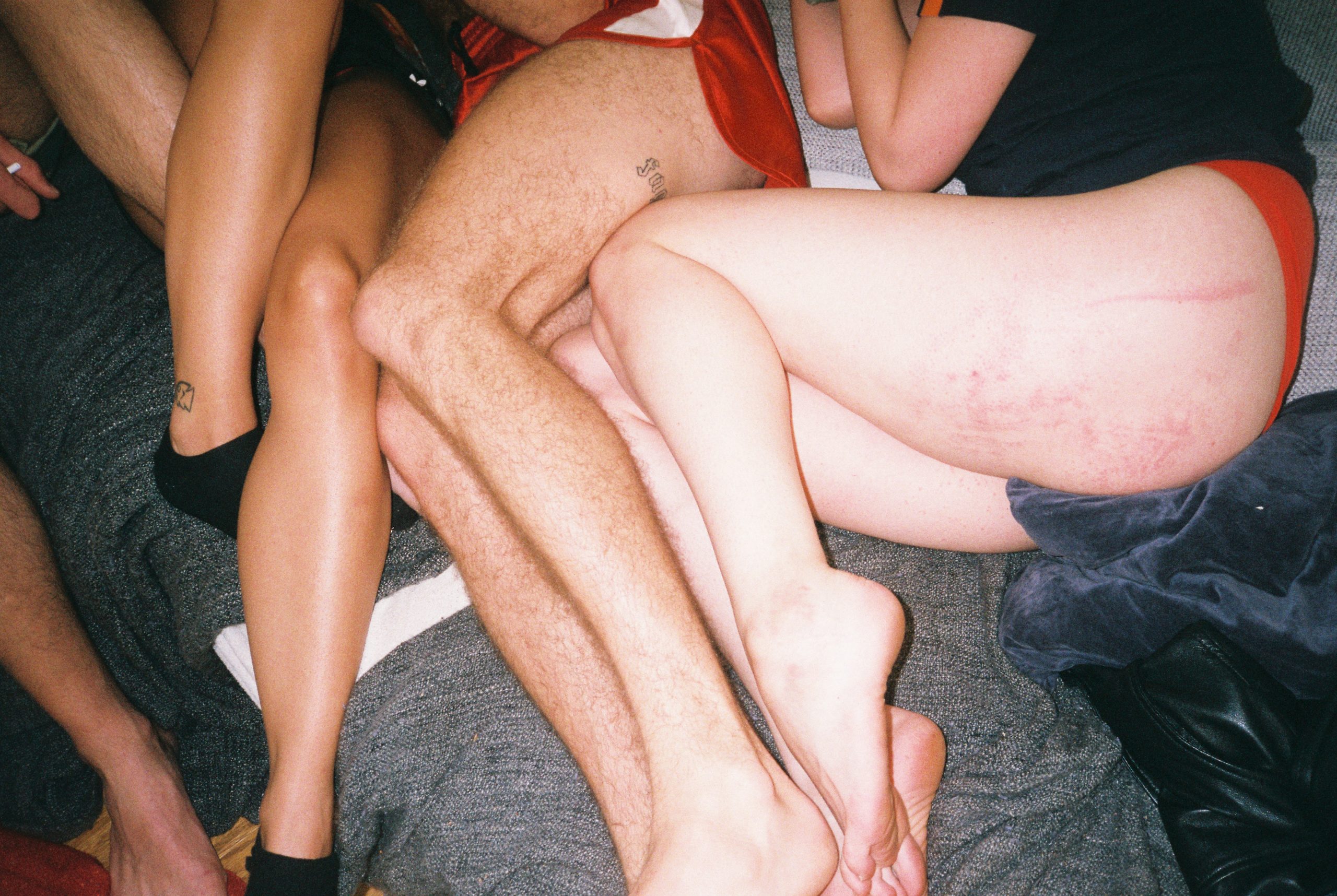
Spyros Rennt: ‘Hanging out at Ludo’s,’ 2020, Fotografie 40 x 60 cm // Courtesy of the artist and the Schwules Museum
One of the features of ‘Intimacy’ that immediately struck me was how central photography was to the exhibition. In addition to photographic works by a number of artists, photography as an action and conceptual subject also features in paintings and video works throughout the show. There is always something performative in a photograph, whether staged or impromptu, but there is also always something intimate, too. Photographs are not entirely real, but even the most heavily-manipulated digital photo is grounded in a kind of material experience, and, therefore, brings with it the intimate verities of experience. I was reminded of this dimension of photography in works by Clifford Price King and Derrick Woods-Morrow in particular. King’s untitled work from 2018 explores the ways the camera reveals and conceals, how images are captured and manufactured for public viewing. Hands are everywhere in the image, both visibly and as ghostly residue as fingerprints on a mirror. The evocation of the “handiwork” that lies beneath photographic production offers a subtly powerful reminder of the deeply personal aspects of a photographic practice, and the points of tension the medium reveals. Woods-Morrow’s work’s title, ‘Watching you watch us, but caring less…,’ is a mediation on the torsions of photography as a site of power contestation. The artist and a collaborator place their cameras at the centre of the image, literally centring the photographic gaze, in this case a Black, queer gaze that may or may not “care less,” but which seems to ask the viewer to question the ends to which caring and the rhetoric of caring are put.
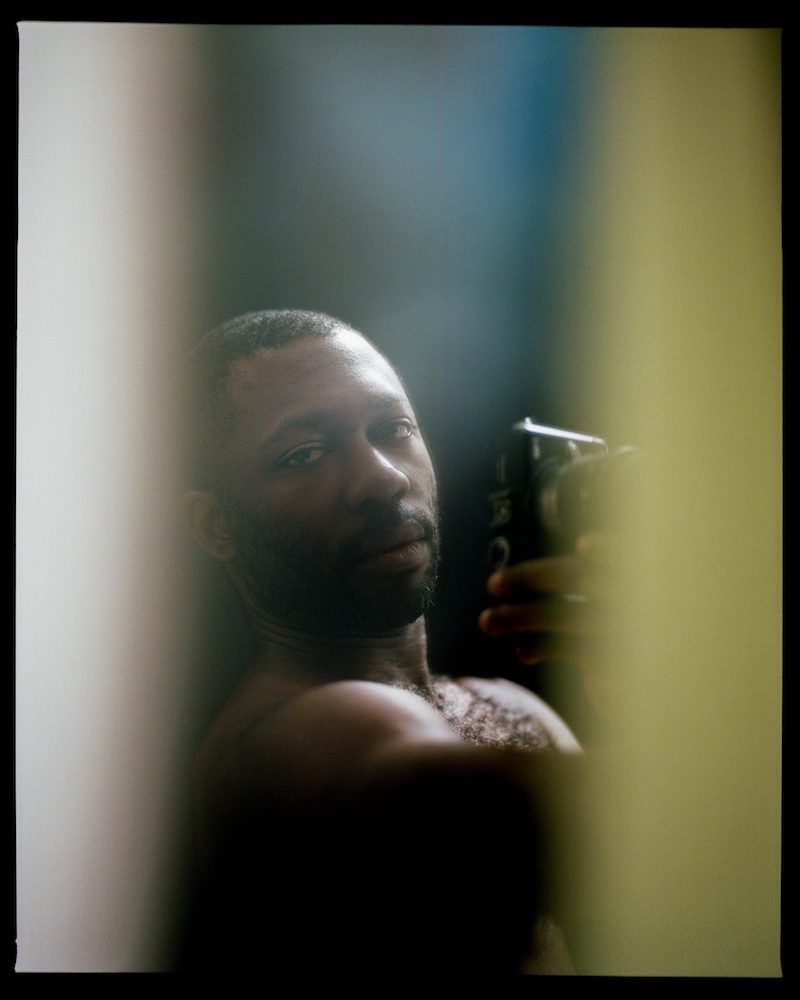
Emerson Ricard: ‘Untitled,’ 2018, photograph // Courtesy of the artist and the Schwules Museum
Photos by Zanele Muholi, a South African artist, depict intimate scenes of South African LGBTQIA+ lives with a delicacy and tenderness that is nevertheless shot through with a lucent vein of defiance. The images of Katlego Mashiloane and Nosipho Lavuta bathing and embracing in bed attest to a determination to love in the face of loveless power systems and social hierarchies. There is also a raucous tenderness to photographic works by Spyros Rennt and Del LaGrace Volcano. Rennt’s images depict moments in the ecstatic communion of club life and its aftermath. Volcano’s works are shot in broad daylight. Both explore the ways queer intimacies negotiate and form space. Risks, rewards, tension, release, relief, the dialogue between Rennt and Volcano’s works were, for me, one of the more powerful subplots of ‘Intimacy’ and its examination of how queerness redefines (or de-defines) spaces.
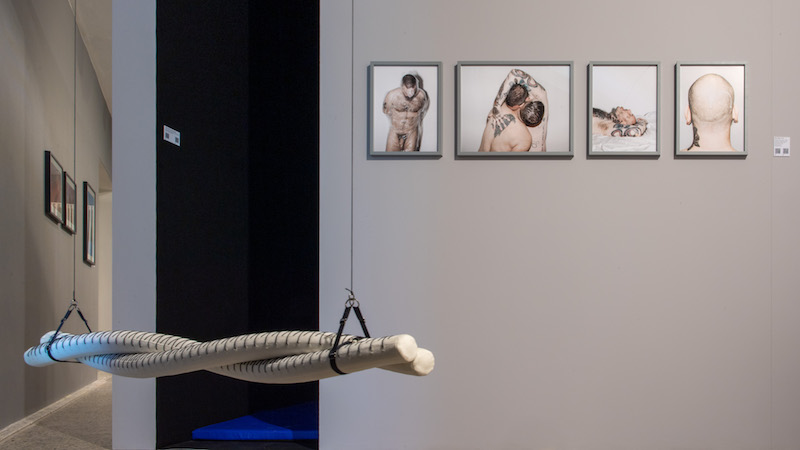
Lucas Foletto Celinski, Studio P–P in ‘Intimacy: New Queer Art from Berlin and Beyond’ at Schwules Museum // Photo by Ralf Rühmeier/SMU
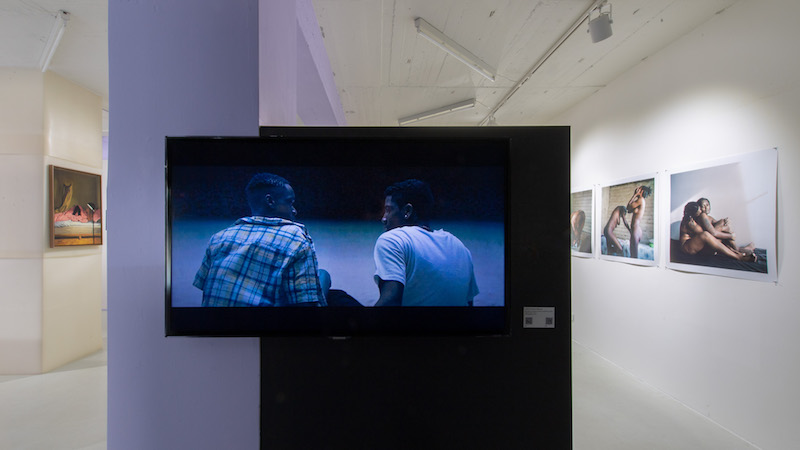
Sholem Krishtalka, Jean Paul Ricco, Zanele Muholi in ‘Intimacy: New Queer Art from Berlin and Beyond’ at Schwules Museum // Photo by Ralf Rühmeier/SMU
The camera and photography also feature in Sholem Krishtalka’s delicate oil interiors, and in works by Michaela Melián and by Simon Fujiwara. In the latter works, photography has a more documentary role, in the case of Fujiwara, depicting images from the AIDS crisis collaged with architectural prints of the Cathedral de Notre Dame. Melián’s three-channel video centres on the lives and works of Sarah Schumann and Silvia Bovenschen, respectively a celebrated feminist painter and a feminist writer. Their partnership is explored in the work, as is the place of women in art history, pages of a book of women artists flip by in another channel of the video. Queerness and institutions are perhaps inherently in tension, indeed an intimate tension, as these works note. Intimacy can just as easily be a vector of violence, as Lampropoulos’ curator’s essay notes in the exhibition’s accompanying fanzine (a number of other queer zines are also on display in the exhibition’s first room). Lampropoulos’ essay discusses the public murder of Zak Kostopoulos/Zackie Oh in Athens in 2018, a bleak reminder that the queering of spaces remains a matter of life and death.
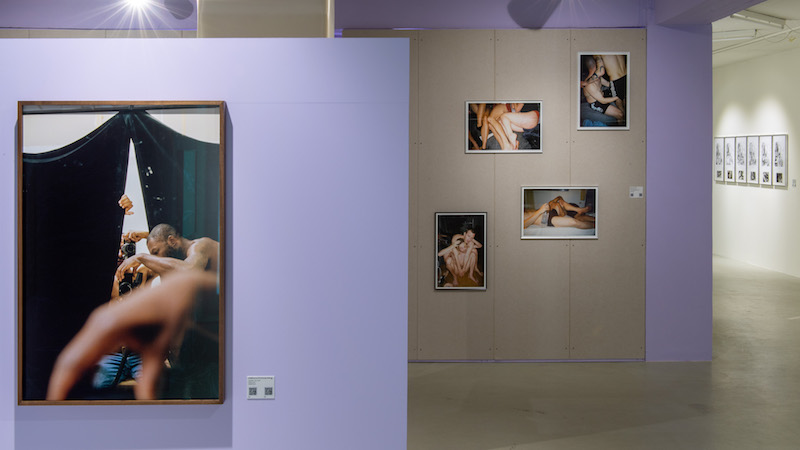
Clifford Prince King, Spyros Rennt, Simon Fujiwara in ‘Intimacy: New Queer Art from Berlin and Beyond’ at Schwules Museum // Photo by Ralf Rühmeier/SMU
To examine queer intimacies in space necessarily entails considering what “intimate space” means in queer sexual discourses. Sexual intimacies are expressed as ardour, as in the audacious oil work ‘Zach and Craig’ by Doron Langberg, an unabashed celebration of gay male sex, and Kerstin Drechsel’s depiction of lesbian desire from her ‘if you close the door’ series from 2010. Rafael Medina’s photo prints from his ‘The End of the Affair’ series are also frank, hazily romantic paeans to public sexual intimacy in queer spaces. Sexual intimacy concerns desire, but also exploration, trust and a kind of blissful absurdity in Vika Kirchenbauer’s video installation ‘The island of perpetual tickling’ (2018). The work features a young performer tied to sheeted mat where two interlocutors relentlessly apply various tickling techniques. A ticklish work indeed for those viewers with sensitive flanks.
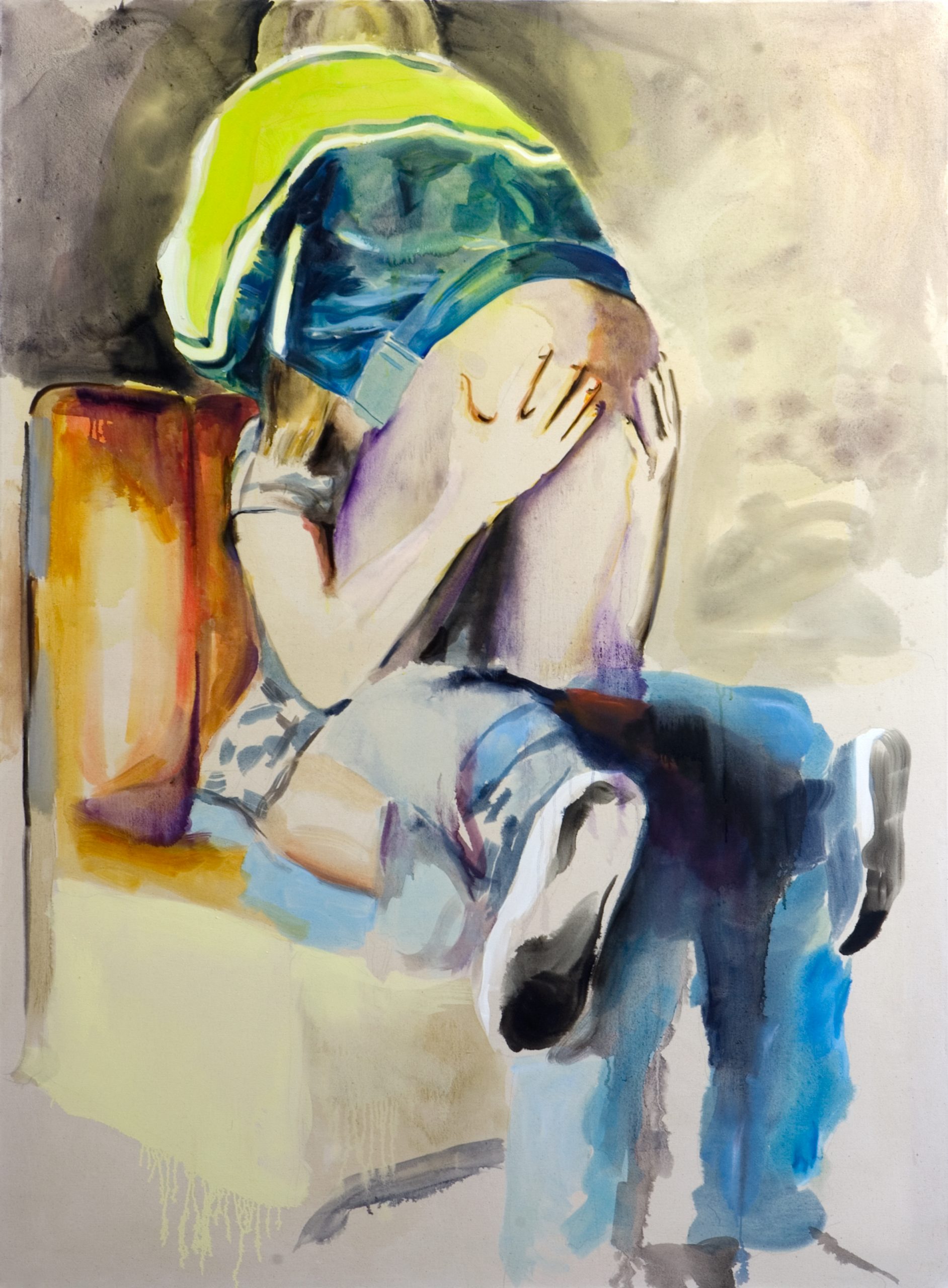
Kerstin Drechsel: ‘Untitled,’ from the series ‘if you close the door,’ 2010, oil auf Nessel, 190×140 cm // Courtesy of the artist and Schwules Museum
A work from 2020 by Cibelle Cavalli Bastos, ‘Hardcore Cuddling’, brings the show to the present. A fish-eye lens rotates as a couple embrace on a bed in a sunny bedroom. The work expresses the dilemmas of COVID-age intimacy, where proximity can, once again, prove lethal. Bastos’ video evokes the kind of hyper-proximity the age of the high definition webcam has wrought, and the strange intimacies it licenses, but also the anxieties it belies; cuddling as refuge and as contraband.
It would be antithetical to the intellectual project of queerness to seek simple conclusions about the future of intimacy in the Schwules Museum’s exhibition, but it poses questions that those of us living now are blessed and cursed with the task of consciously addressing. As humans we need intimacy, and intimacy manifests in potentially infinite forms; our lives will be defined by the ways in which we seek and create it. The exhibition is less about proposing models—though some artists involved do have very definite ideas about what queer intimacy means to them—it is more about opening doors, and, mercifully, doors are opening all around Berlin these days.
This article is part of our feature topic of ‘Intimacy.’ To read more from this topic, click here.
Exhibition Info
Schwules Museum
Group Show: ‘Intimacy: New Queer Art From Berlin And Beyond’
Exhibition: Dec. 3, 2020–Aug. 30, 2021
schwulesmuseum.de
Lützowstraße 73, 10785 Berlin, click here for map




















